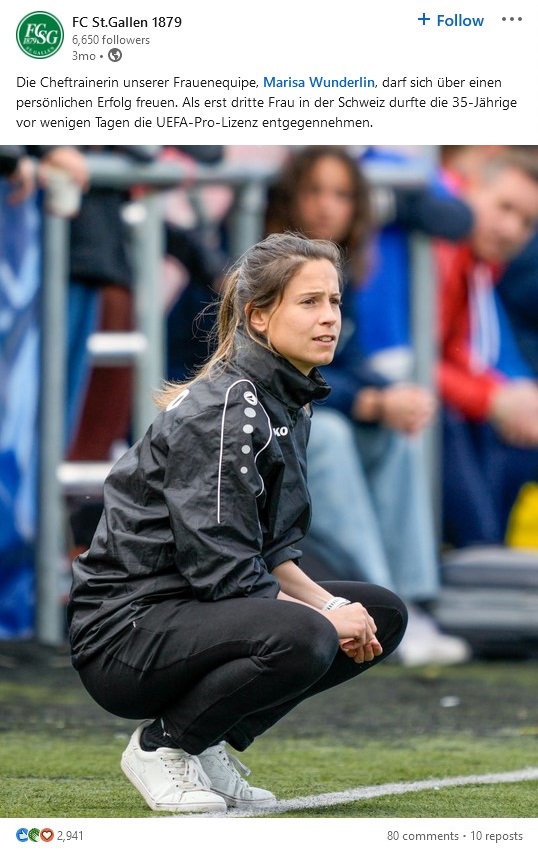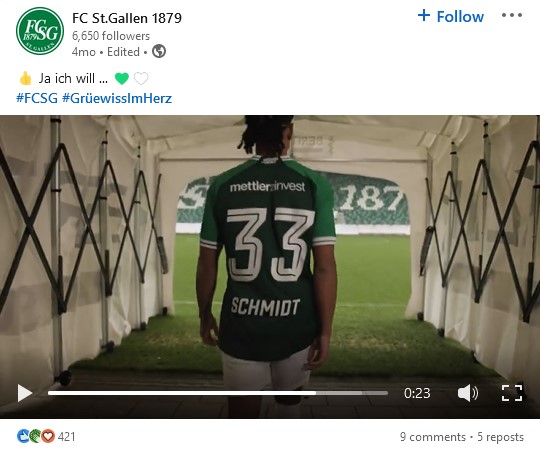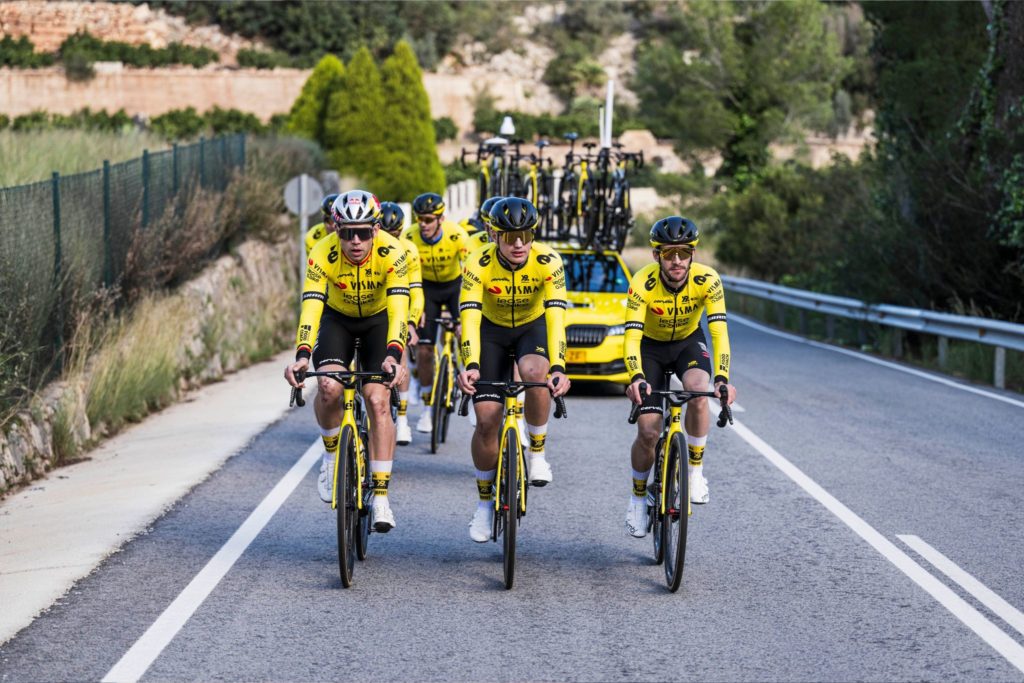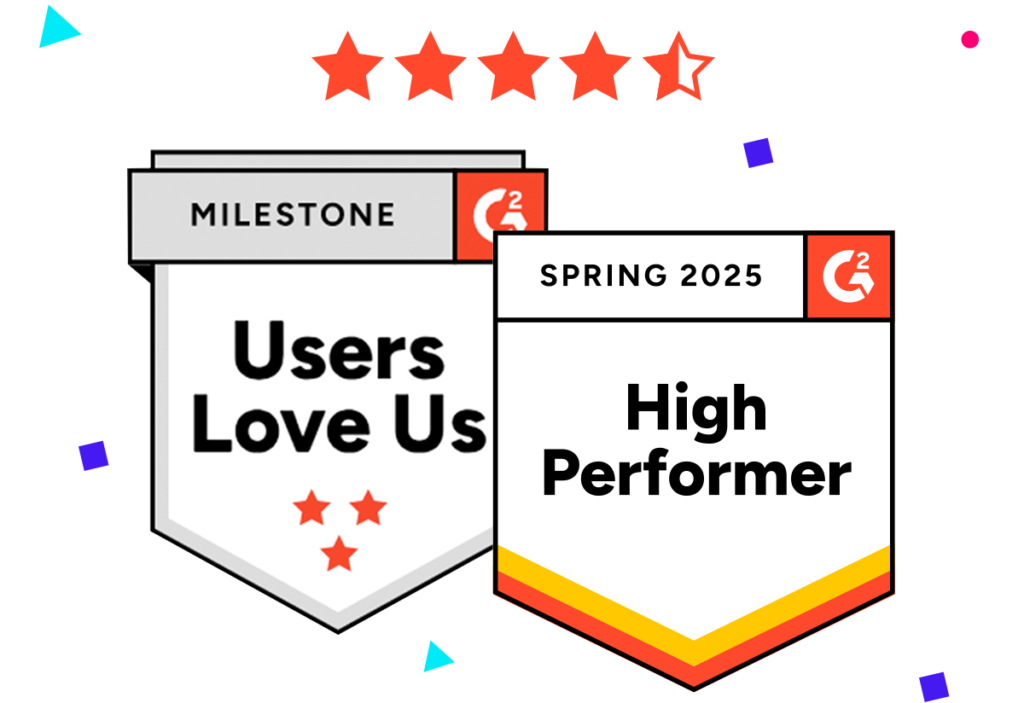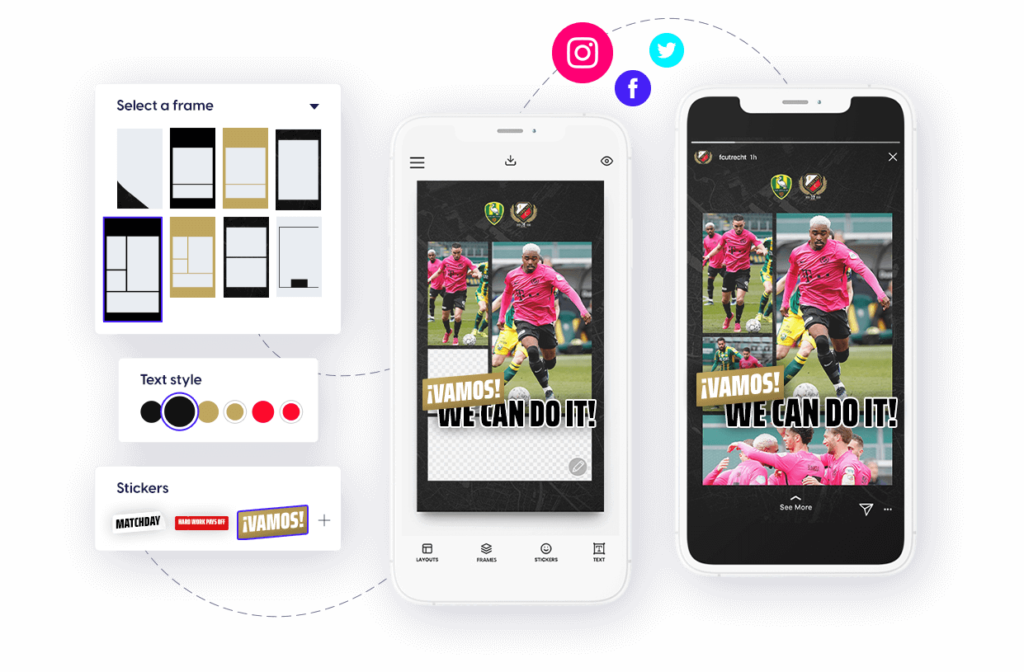Troy Lüchinger is the Chief Marketing Officer at Swiss football club FC St.Gallen 1879, and a Content Stadium client. Based on his 5 years at the club and previous experience in multiple roles in leading digital agencies, we asked Troy to share his top social media recommendations and learnings.
Q. What is your top advice for social media managers of football clubs and other sports organizations?
Troy Lüchinger: Based on my experience, I have three key values and recommendations to share with other social media managers in similar roles.
First, don’t take on more social media channels than you and your team can manage. If you do not have enough resources, it’s impossible to be active and post quality content regularly on every social media platform from Instagram to TikTok. For organizations that have limited capacity and cannot be present on every channel, I recommend choosing the social media channels where the majority of their target group is present. For example, for us as a national football club, TikTok is proving slightly less relevant, because it mainly has an international audience.
Second, you need to find the right tools and software to support you with your daily work. For example, we use Content Stadium templates to quickly generate our social media visuals. We have templates ready for matchday and day-to-day posts, which ensure our processes are efficient and our visuals are on-brand.
Third, make sure to define your social media processes — from creating your content to publishing it. For example, when your team scores a goal in a match, how will you be able to get the photo of the goal, create your post, and post it, all within 5 minutes? It’s so important to have this formula set and to optimize it continuously, in combination with platforms like Content Stadium which can support you in this process.
You need to find the right tools and software to support you with your daily work. For example, we use Content Stadium templates to quickly generate our social media visuals.
Q. What content do you find works best on social media?
Troy: Everything that happens during a matchday interests the fans. That’s a no-brainer. From reporting on the match itself to the pre-match build-up and the post-match coverage. But what’s even more interesting is what goes on behind the scenes. Behind-the-scenes content is particularly popular because it allows fans to get exclusive insights. They get access to the people behind FC St.Gallen 1879, which helps to build a feeling of connection and closeness.
To provide an example, we asked staff and players to film themselves during a recent training camp in Spain, just using their mobile phones. We then turned this content into two videos for social media. The important thing here is to just show what’s going on behind the scenes, the quality of the videos themselves does not have to be perfect. Sometimes, it even helps if the video is a bit rough and unpolished — that’s one trend we’re seeing at the moment. And you can still generate something great from it.
Additional topics which always attract attention, according to my experience, are quizzes and polls — once again, Content Stadium provides great features for such social media posts, as well as interactive quiz widgets to embed on webpages. Background information about the club and its goals in general also perform well on social media.
Q. Have you tried something in the past that didn’t work on social media?
Troy: Of course, there are always posts that don’t perform well. First, the time when you post and how much you post play a role. If you post a lot, certain posts simply don’t get much visibility.
In terms of content, one thing I have learned is that “content is king.” It may sound obvious now, but posting interesting and entertaining content is the be-all and end-all of social media. Clubs should not see their social media channels as advertising platforms. And in our case, if content didn’t work on social media, it mostly had to do with the fact that it was too obviously about advertising purposes.
For example, our sponsor used to feature too heavily in the intros and outros of our video clips at one point. Those posts simply didn’t get a high reach. Therefore, the lesson learned here was that the sponsor logo should be more discreet, or even better, be integrated into the cub’s corporate design rather than look like an ad.
Q. Do you have a different strategy for each of your social media channels?
Troy: Yes, definitely. We do not feed all our social media channels in the same way. At the moment, Twitter, Facebook, Instagram, TikTok and LinkedIn are our primary channels:
- On Twitter, you can only share brief messages. Thus, we share links to redirect users to our own channels (website or video platforms) for more information.
- We mainly use Instagram as an entertainment channel. Here we’re relying more heavily on videos and photos for the feed, and graphics for Stories.
- On Facebook, we’re still achieving maximum returns when it comes to merchandising promotions and sales. And above all, we can write longer texts on this channel, and people will read them. Although, of course, the video is king.
- We started with TikTok, then stopped, then started again. I think that we still lack a clear strategy for this channel. But what is very exciting about TikTok is that, by posting cheeky content, even as a regional club that doesn’t have a huge international following, we can still reach global audiences. Swiss club Servette FC are a great example of this.
- LinkedIn is our fastest-growing channel right now. The audience here is very diverse, including Gen Zs. This requires a bit of a balancing act. Should we only post corporate communications? Or should we also bring some fun and entertainment? We’ve started posting more sports- and entertainment-related content, which is performing surprisingly well on what is essentially a “business” platform. We are now posting around 70% corporate communications and 30% entertainment content on LinkedIn.
Q. What are your main goals for social media?
Troy: When it comes to social media KPIs, I think that reach and followers are not everything. I’ll give you an example: Swiss club FC Basel has a huge number of followers on Facebook. This is partly because Egyptian player Mohamed Salah (who is now playing for Liverpool) was once in their team, and he himself has a large number of followers. But the club doesn’t do any business with these followers.
Instead, our primary social media goal is to strengthen the FC St.Gallen 1879 brand. To achieve this, we focus on having a uniform visual language, sharing emotional images, and conveying our club values. We want our content to connect with fans, and to attract new followers who then become fans. We’re not looking to appeal to people who will never become fans of our club.
Of course, we also have commercial goals. Giving visibility to sponsors and increasing income through merchandising and ticketing are also part of our digital communication responsibilities.
Q. How do you ensure that your content stays on-brand, without being too repetitive?
Troy: We work with a corporate style guide, which includes guidelines for our website and social media visuals. It outlines how to prepare video content, which design elements to incorporate, how to edit images, use fonts, etc. We also refresh these guidelines and our style each season.
We then use different tools and platforms to support our brand. For example, we work with custom-built templates in Content Stadium to create on-brand content. We also equip our freelancers, who are less familiar with our brand, with the Content Stadium LIVE mobile app to help them create content within our guidelines during matchdays.
#YBFCSG 1️⃣1️⃣ ⬇️#FCSG #GrüewissImHerz pic.twitter.com/qXbbi4yFvH
— FC St.Gallen 1879 GRÜEWISS IM HERZ (@FCSG_1879) February 12, 2023
But we try not to be too rigid with our brand. Social media thrives on variety. Therefore, we have developed two or three variants of each template design in Content Stadium, while keeping other elements fixed, such as our player database.
Q. Are there other clubs that inspire you when it comes to social media?
Troy: Definitely. There are plenty of clubs who make me think about where we can go next and how we can improve. Here are just some examples:
- Eintracht Frankfurt has a strong brand with great visuals on social media.
- Servette FC does an amazing job on TikTok with cheeky and entertaining content. The club has clearly positioned its values there, and some of its videos receive millions of views.
- BVB produces some great video content and formats, such as their Quiz Taxi. It’s also great to see them on Twitch.
- PSG uses some standout graphics, with detailed and nuanced visuals.
- Liverpool and Man City are good examples from the Premier League.
- In the Netherlands, PSV and Ajax in particular are doing a standout job. They use beautiful graphical elements to enrich their stories and level up their brands, while also ensuring plenty of variety.
@servettefootballclub 𝓜𝓮𝓼𝓭𝓪𝓶𝓮𝓼 𝓮𝓽 𝓜𝓮𝓼𝓼𝓲𝓮𝓾𝓻𝓼… 𝗞𝗲𝘃𝗶𝗻 𝗠𝗯𝗮𝗯𝘂 fait son retour au Servette FC ! 🔥🤩
♬ son original – Catch-Newz
Q. What are you planning to try next on social media?
Troy: Right now, I’ve identified 3 pains or opportunities to focus on:
- TikTok: Our approach isn’t working right now, so we have to decide if TikTok is a good channel for FC St.Gallen 1879 and our brand DNA. And if so, we need to invest strategically in the channel.
- Instagram stories on matchdays: We want to avoid the repetitive matchday stories as we know them: team bus arrives, players go in, warmup, kick-off, photos, end of game. Instead, we are looking to bring more authenticity and deeper content to our fans. One approach we want to work on is to show different points of view on gamedays: sometimes from the coach’s perspective, sometimes from the players, the staff, the fans, etc.
- Instagram Reels: We want to invest more effort here, including posting a Reel before every kick-off, reusing the content we’re already producing for the stories. We already have two videographers at FC St.Gallen 1879 to support our Reels and other video content.
Q. What social media trends are you noticing in the sports industry?
Troy: One big change I’m observing is that more and more football clubs, especially the big, international clubs, are turning into media companies. Originally, social media was focused on matchday coverage. But clubs are now posting more entertainment-related content on their channels — from quizzes to videos and interactive content, while gameday content is becoming more of a hygiene factor.
And, as we talked about earlier, channels such as TikTok allow smaller, regional clubs to play a role in the international entertainment scene, with the possibility for enormous reach. Nowadays, social media makes it possible for clubs to develop a brand outside of football as a core business.
More social media tips for sports
Looking for more best practices and inspiration for your football club or sports organization? You might also be interested in these articles:
- Be inspired by 36 sports social media template designs.
- Read our interview with Jordy Koppen, Acting Head of Content & Media at PSV Eindhoven, on his own learnings and best practices at the Dutch football club.
- Discover 15 ideas and strategies for your football social media channels.
- Find out more about our content creation platform, including why Tennis Canada and the European Handball Federation call it a “life-saver” for sports (social) media teams:

